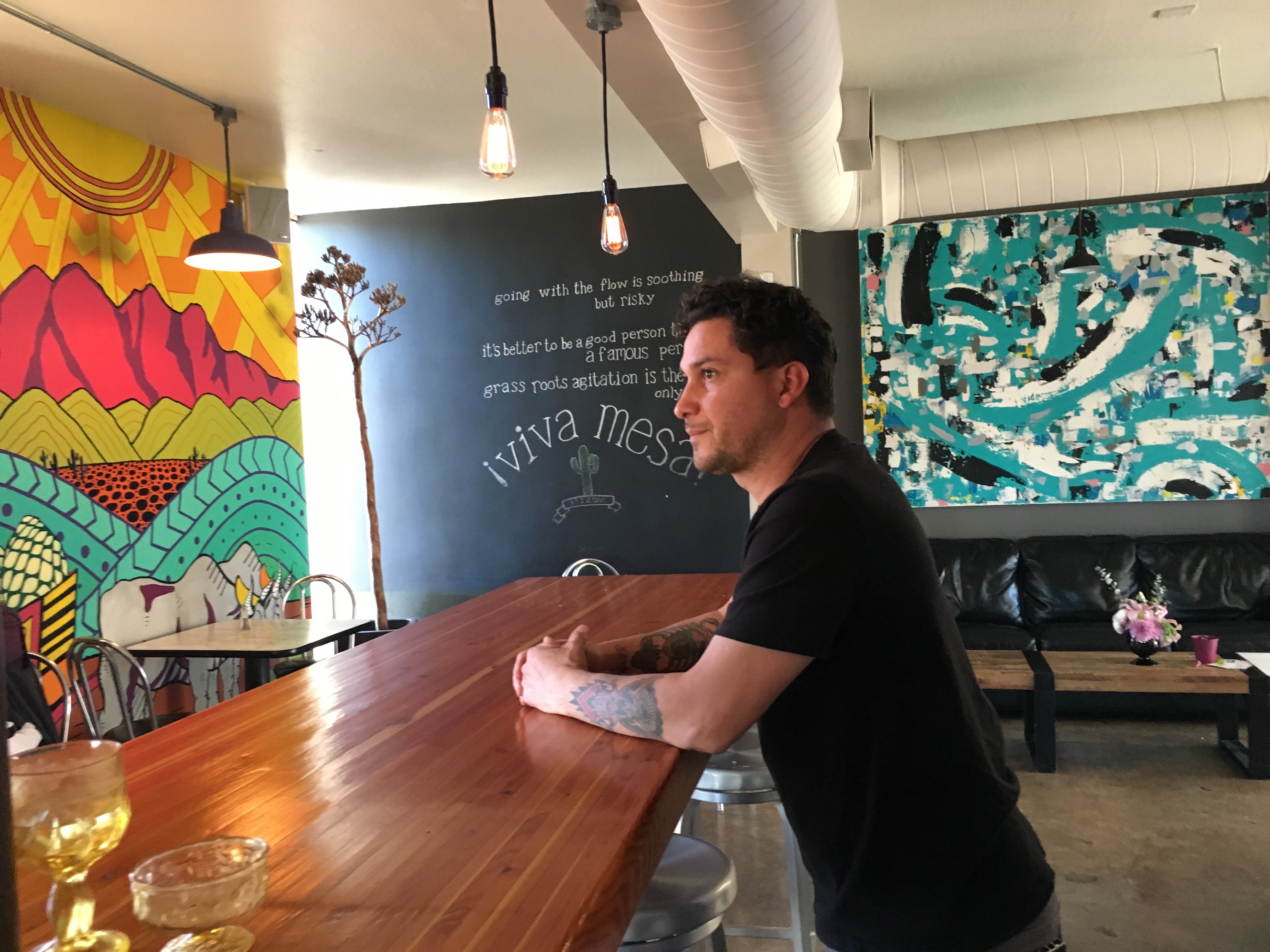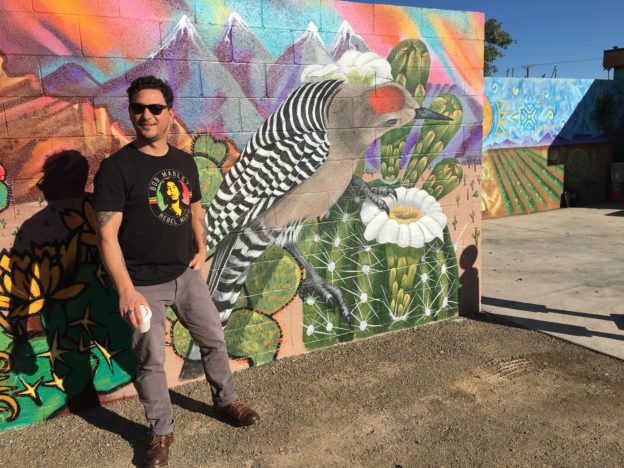(Note: This blog is an installment of the LISC Phoenix monthly series, “Communities on the Line.”)
On a sunny March afternoon in downtown Mesa, a rooster’s call is louder than a light-rail train’s toots, a retiree tends a plot of an urban garden wrapped in local artists’ murals, and a party of four repeat customers talks shop during a meal at a restaurant with Mesa roots running deeper than the business planted there four years ago.
Welcome to LISC-style economic development. The nonprofit’s focus on small business, transit-oriented development and creative placemaking to help build community are on full display at the Southside Heights commercial corner that is home to the popular República Empanada restaurant and the Mesa Urban Garden.
The northeast corner of First Avenue and Hibbert Street, just south of Main Street, is also an example of an effective “survive and thrive” community development strategy to help neighborhoods through the disruption of Valley Metro light-rail construction.
“Community development is community building,” said Terry Benelli, executive director of LISC Phoenix. “You accomplish that by building trust with residents and businesses of the neighborhood. I’m really proud of how things happened.”
A collaborative effort between the city and community organizations like the Neighborhood Economic Development Corporation is credited with producing a net-zero business loss rate for the light-rail extension through downtown Mesa.
That’s a starkly different result from other light-rail construction projects in the region. Initial light-rail construction in Phoenix that began in 2005 and the 19th Avenue extension that opened in March 2016 caused significant business closure. A net-zero business loss rate is the goal for future light-rail construction projects, including the 5.5-mile South Central Extension in Phoenix.
NEDCO, then led by Benelli, was the driving force behind the early-action business assistance program that began a year before the start of light-rail construction through downtown Mesa. This was not a handout. To gain access to grants, workshops, consultants and technical assistance specific to their needs, business owners were required to participate in monthly meetings. Placemaking ideas, such as special events, murals and alleyway beautification, rose up from merchant meetings, as did new leadership groups, such as Retail, Arts, Innovation and Livability or RAIL.
Mesa native Marco Meraz, manager of his family’s República Empanada, admits going into the pan-Latin restaurant venture with lots of “naïve confidence” and some ignorance about running a business. He took full advantage of the early-action business assistance program that helped him manage opening a restaurant during the middle of light-rail construction.
 “I really credit those workshops,” Meraz said. “As far as the tailored stuff, we had a consultant they hired to help us do a business plan and there was a separate restaurant consultant that helped us layout the blueprint for the restaurant and how to execute opening the doors.”
“I really credit those workshops,” Meraz said. “As far as the tailored stuff, we had a consultant they hired to help us do a business plan and there was a separate restaurant consultant that helped us layout the blueprint for the restaurant and how to execute opening the doors.”
Meraz, who grew up near downtown Mesa, likes the trajectory he sees in his hometown.
“Mesa is actually starting to happen,”Meraz said. “I don’t know how else to say. It’s going to be a lot different five years from now. … We’re at that tipping point. It’s people like ourselves, small business owners like ourselves, who have been putting our livelihood on the line for a long time trying to make it happen here however we can. It usually comes at our expense. We lay the groundwork for developers and people with capital to come in and start doing bigger and better things. I’m OK with that. We’re confident in our place here.”
And so about a place in downtown Mesa late one afternoon of a sunny March day.
Ruben Garcia, a Raytheon retiree who relocated last summer from Tucson to Mesa in an area southwest of downtown, happened upon the urban garden while riding his bicycle through the neighborhood. Time files when he tends his rented plot, he said during a stop at República Empanada after spending hours at the garden that produces food for families, food banks and local restaurants.
On República Empanada’s patio, a group from the Lincoln Center in New York on another business trip to the Mesa Arts Center, lingers after lunch. The visitors have made several trips to Mesa during the past few years.
“They just finished telling me that every time they come here they eat lunch here every single day, the entire time they’re here,” Meraz said. “They said, ‘You’re the first place we come to when we land. We love your place.’ I told them — and I hope they believe me, I hope they understand — how flattering that is and how much I swell with pride.”
A rooster calls, a train toots, long shadows fall over colorful murals as more people gather at an interesting place. And a restaurant owner’s confidence is no longer naïve.
